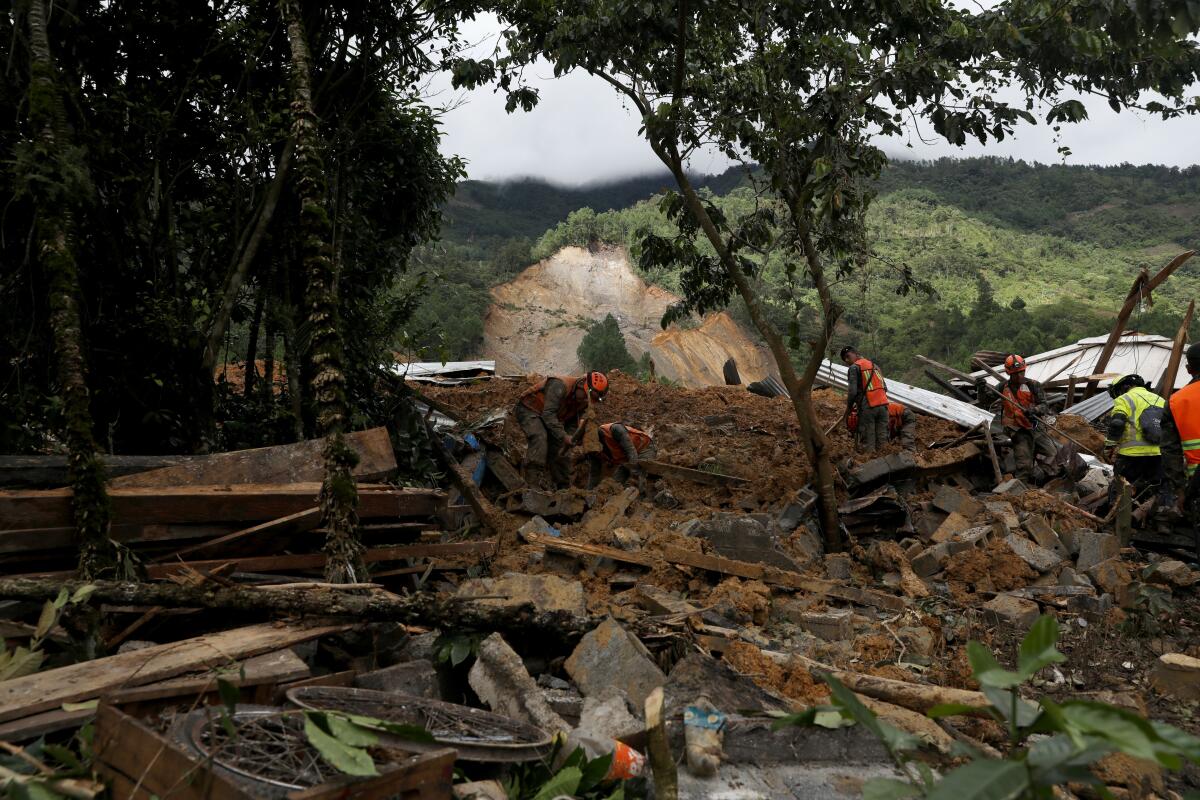Tropical storm Eta makes landfall in Florida Keys

- Share via
PURULHA, Guatemala — A strengthening tropical storm Eta made landfall Sunday night on Florida’s Lower Matecumbe Key, days after after leaving scores of people dead and more than 100 missing in Mexico and Central America.
The U.S. National Hurricane Center in Miami declared hurricane and storm surge warnings for the Keys from Ocean Reef to the Dry Tortugas, including Florida Bay, with the storm expected to reach that area by Sunday night or early Monday.
Florida officials closed beaches, ports and COVID-19 testing sites, shut down public transportation and urged residents to stay off the street. Shelters opened in Miami and the Florida Keys for residents in mobile homes and low-lying areas.
Broward County shut down in-person schooling Monday, and Miami appeared poised to do the same.
On Sunday night, authorities in Lauderhill, Fla., responded to a report of a car that had driven into a canal. Photos taken by fire units on the scene, about 30 miles north of Miami, showed rescuers searching what appeared to be floodwaters near a parking lot. Firefighters pulled one person from a car and took the patient to a hospital in critical condition, according to a statement from the Lauderhill Fire Department’s public information officer. Responders were continuing to search for others.
Eta had maximum sustained winds of 65 mph Sunday evening and was centered north of Cuba, about 65 miles east of Marathon, Fla., and about 90 miles south-southeast of Miami. It was moving northwest at 14 mph.
The storm swelled rivers and flooded coastal zones in Cuba, where 25,000 people were evacuated. There were no reports of deaths.
Eta hit Cuba as searchers in Guatemala were still digging for people believed buried by a massive, rain-fueled landslide. Authorities on Sunday raised the known death toll there to 27 from 15 and said more than 100 people were missing in Guatemala, many of them in the landslide in San Cristobal Verapaz.
Some 60,000 people had been evacuated in Guatemala.
At least 20 people were reported dead in southern Mexico. In Honduras, local officials reported 21 deaths, though the national disaster agency confirmed only eight.
Pope Francis on Sunday spoke about the population of Central America, hit “by a violent hurricane, which has caused many victims and huge damage, worsened as well by the already difficult situation due to the pandemic.” Speaking to faithful gathered at St. Peter’s Square in Vatican City, the pope prayed that “the Lord welcome the deceased, comfort their families and sustain those most in need, as well as all those who are doing all they can to help them.”
Florida Gov. Ron DeSantis declared a state of emergency Saturday for eight counties as Eta approached, urging residents to stock up on supplies.
Miami-Dade County declared a state of emergency Friday night and warned that a flood watch would be in effect through Tuesday night.
Further south, in the Keys, officials were monitoring the storm closely but had no plans to evacuate tourists or residents. They urged residents to secure boats and encouraged visitors to consider altering their plans until Eta had passed.
“Residents need to monitor this storm and be prepared for high tropical-storm-force sustained winds and hurricane-strength gusts,” said Shannon Weiner, director of emergency management for Monroe County.
Eta was once a Category 4 hurricane, and authorities from Panama to Mexico were still surveying the damage following days of torrential rains during the week.
In Guatemala, search teams had to overcome multiple landslides and deep mud just to reach the site where officials have estimated that some 150 homes were destroyed.
In the worst-hit village, Queja, at least five bodies have been pulled from the mud. The Indigenous community of about 1,200 consisted of simple homes, wooden with tin roofs, clinging to the mountainside.
Rescue workers used a helicopter to evacuate Emilio Caal, who said he lost as many as 40 family members. Caal, 65, suffered a dislocated shoulder when the landslide sent rocks, trees and earth hurtling onto the home where he was about to sit down to lunch with his wife and grandchildren. Caal said that he was blown several yards by the force of the slide and that none of the others got out.
“My wife is dead; my grandchildren are dead,” said Caal from a nearby hospital.
Ruben Tellez, a spokesman for firefighters in Guatemala, said at least one additional person died Sunday when a small plane went down while carrying emergency supplies to the stricken area.
In neighboring Honduras, 68-year-old María Elena Mejía Guadron died when the brown waters of the Chamelecón River poured into San Pedro Sula’s Planeta neighborhood before dawn Thursday.
In southern Mexico, across the border from Guatemala, 20 people died as heavy rains attributed to Eta caused mudslides and swelled streams and rivers, according to Chiapas state civil defense official Elías Morales Rodríguez.
The worst incident in Mexico occurred in the mountain township of Chenalhó, where 10 people were swept away by a rain-swollen stream; their bodies were found downstream.
Flooding in neighboring Tabasco was so bad that President Andrés Manuel López Obrador cut short a trip to western Mexico and was flying to Tabasco, his home state, to oversee relief efforts.
Hurricane Eta’s arrival Tuesday in northeast Nicaragua followed days of drenching rain as it crawled toward shore. Its slow, meandering path north through Honduras pushed rivers over their banks.
More to Read
Sign up for Essential California
The most important California stories and recommendations in your inbox every morning.
You may occasionally receive promotional content from the Los Angeles Times.













